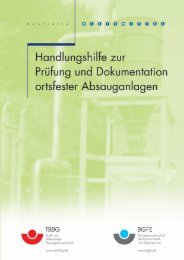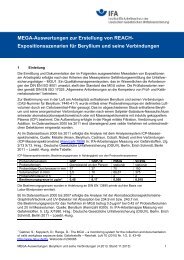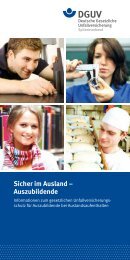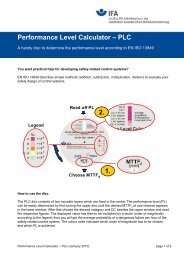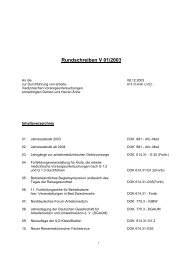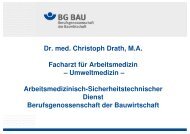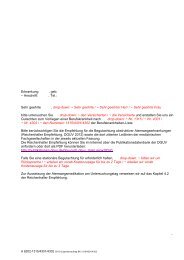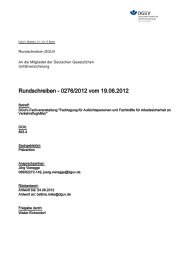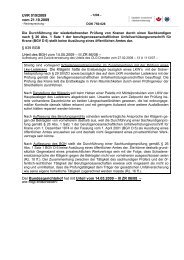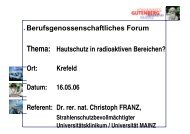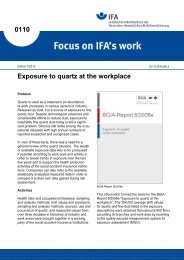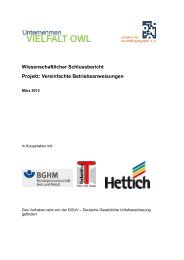Effectiveness of measures to prevent needlestick injuries among ...
Effectiveness of measures to prevent needlestick injuries among ...
Effectiveness of measures to prevent needlestick injuries among ...
You also want an ePaper? Increase the reach of your titles
YUMPU automatically turns print PDFs into web optimized ePapers that Google loves.
5 Cost effectiveness<br />
realistic for IV line connec<strong>to</strong>rs (a needleless system), but not for other devices<br />
considered [98].<br />
Dugger described the introduction in 1990 <strong>of</strong> safer needles and needleless IV systems<br />
in a large US hospital. Before the implementation, costs <strong>of</strong> safer devices were esti-<br />
mated at $ 172,000, with no disposal and indirect costs considered. However, re-<br />
venue gains were expected from "chargeable items" and through the introduction <strong>of</strong><br />
a secondary backflush technique that saved on the number <strong>of</strong> primary IV tubing sets.<br />
The hospital expected a revenue increase <strong>of</strong> around $ 20,000 after all <strong>of</strong> these prod-<br />
ucts were introduced. Costs for NSI were taken from the literature ($ 1,000). Based on<br />
a 69 % reduction per half year, <strong>to</strong>tal estimated savings were $ 55,000. Costs <strong>of</strong> NSI<br />
have not been calculated in this study, and no cost-benefit analysis was conducted.<br />
Overall, it was not obvious in this paper which <strong>of</strong> the costs and savings were estimated<br />
a priori and which actually occurred [104].<br />
Laufer and Chiarello conducted a cost-effectiveness analysis using pooled data from<br />
ten US hospitals. Using additional assumptions, they estimated the average cost <strong>of</strong> a<br />
NSI at $ 363 in 1992, and included testing and PEP for HBV and HIV as well as<br />
"personnel" costs. HCV and costs in case <strong>of</strong> seroconversion were not included. For two<br />
participating hospitals, a cost-effectiveness analysis was conducted comparing two<br />
categories <strong>of</strong> safer devices, injection equipment and IV delivery systems. The safety<br />
syringe was reported <strong>to</strong> lead <strong>to</strong> a reduction <strong>of</strong> 30 % in the half-year observation period<br />
at a cost <strong>of</strong> $ 984 per injury <strong>prevent</strong>ed. The needleless IV system in the other hospital<br />
led <strong>to</strong> a 94 % reduction in <strong>injuries</strong> at $ 1,877 per injury <strong>prevent</strong>ed. The incremental<br />
costs <strong>of</strong> introducing the IV needleless system were higher than the costs <strong>of</strong> the equip-<br />
ment selected by the first hospital. It should be noted that the objective <strong>of</strong> the Laufer<br />
and Chiarello study was <strong>to</strong> introduce the methodology <strong>to</strong> infection control practitioners<br />
rather than <strong>to</strong> carry out a formal analysis for a specific institution(s) [99].<br />
H<strong>of</strong>mann et al. [102] estimated the costs <strong>of</strong> a NSI for a large German hospital at<br />
€ 487. The estimate included cost for testing <strong>of</strong> the HCW and source patient, PEP and<br />
lost work time for the HCW. However, the portion <strong>of</strong> the costs affecting the hospital<br />
was estimated <strong>to</strong> be only € 148; the largest part <strong>of</strong> the costs was estimated <strong>to</strong> affect<br />
the worker's accident insurance. Among cost-saving fac<strong>to</strong>rs, the authors reported on<br />
Report „Needlestick <strong>injuries</strong>“ 63



